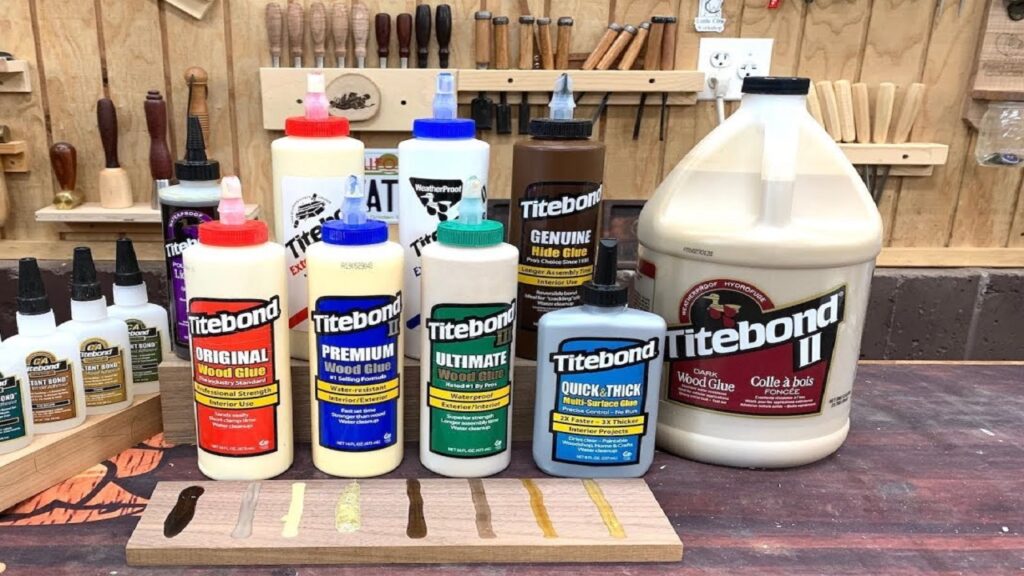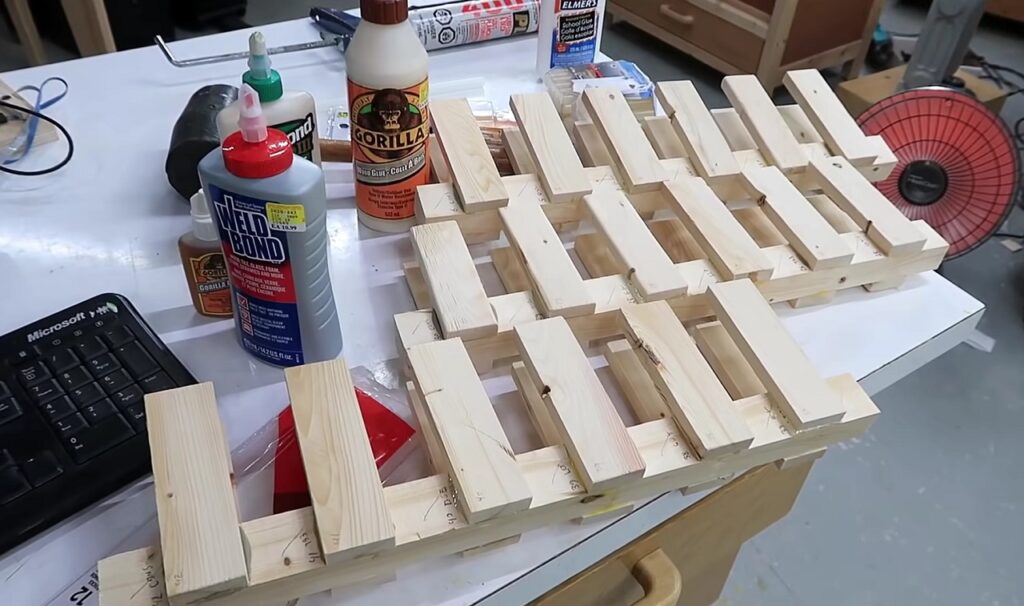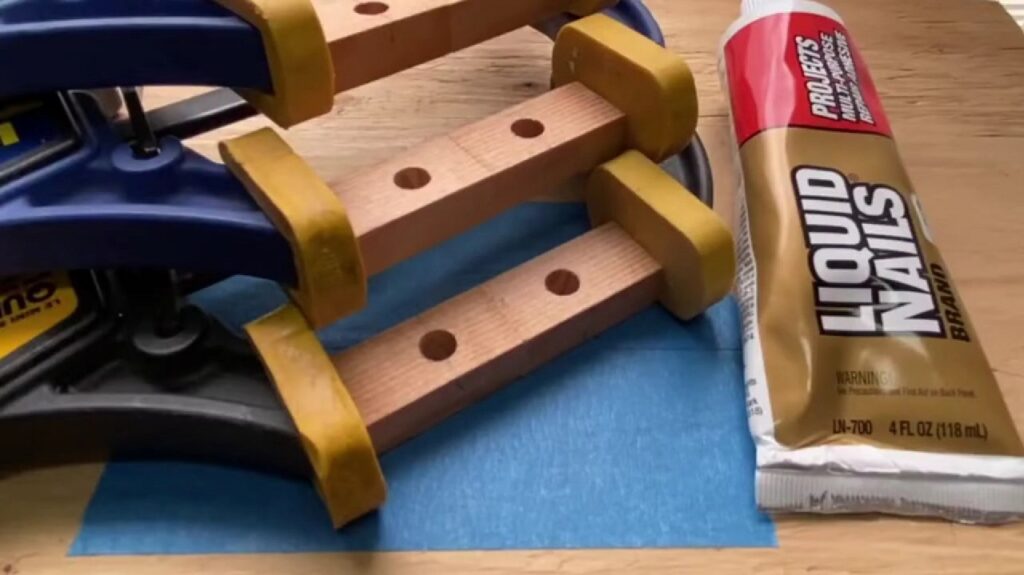Wood Glue Vs Liquid Nails: Choosing the Right Adhesive for Woodworking

Wood glue is most effective when joining two closely matched wooden pieces with a snug fit. Wood glue shines for tight-fitting wood joints, while Liquid Nails tackles broader applications. Liquid Nails proves more suitable for bonding diverse materials or securing wood in instances where the joint between the pieces is loose or exhibits gaps.
Choosing the right one depends on your project’s specific needs. So today we’re going to discuss wood glue vs liquid nails.
Wood Glue Vs Liquid Nails
Here’s a comparison to help you choose the right one for your project:
| Feature | Wood Glue | Liquid Nails |
| Intended Use | Wood-to-wood bonding | Various materials, filling gaps, loose joints |
| Best for | Tight-fitting wood joints | Diverse materials, filling gaps, loose joints |
| Bond Strength | Excellent for well-fitting joints | Superior strength, good for gaps |
| Cleanup | Water-based, easy with water (while wet) | Solvent-based or water-based, check specific product |
| Drying Time | 30 minutes to several hours | Several hours to a day |
| Strengths | Strong bond, Sands well, Easy cleanup, Affordable | Superior strength, Waterproof, Gap-filling, Variety of formulas |
| Weaknesses | Limited material compatibility, Not waterproof, Longer drying time | Messier application, Visible bond, Difficult cleanup, Not sandable, More expensive |
1. Intended Use
- Wood Glue: Primarily designed for bonding wood-to-wood joints.
- Liquid Nails: A construction adhesive versatile for bonding various materials like wood, metal, concrete, and even some plastics.
2. Bond Strength
- Liquid Nails: Generally considered stronger than wood glue, offering superior holding power for heavier objects.
- Wood Glue: Provides excellent strength for well-fitting wood joints, but may not be ideal for heavy loads or applications with significant stress.
3. Chemical Properties
- Wood Glue: Primarily composed of polyvinyl acetate (PVA) with various additives for specific properties.
- Liquid Nails: Solvent-based adhesives containing polymers, resins, and solvents.
4. Shelf Life
- Wood Glue: Generally has a shelf life of 1-2 years when stored properly in a cool, dry place.
- Liquid Nails: Typically boasts a longer shelf life of 24 Months when stored unopened in a cool, dry location.
5. Temperature Range
- Wood Glue: Most wood glues perform well at above 45°F.
- Liquid Nails: Generally have a wider temperature range than wood glue, with some formulations able to withstand temperatures 22° F to 120° F.
What Is Wood Glue Used For?
- Bonding wood-to-wood joints: furniture, cabinetry, trim work.
- Creating strong, rigid bonds: shelves, repairs, crafts.
- Indoor projects: water-resistant, not ideal for outdoor use.
Types Of Wood Glue
- Polyvinyl Acetate (PVA): Most common, strong, affordable, water-based, good for indoor projects.
- Polyurethane: Water-resistant, strong, flexible, good for outdoor projects and oily woods.
- Cyanoacrylate (CA): Super glue, fast drying, strong for small repairs, not ideal for large projects.
- Epoxy: Strongest, waterproof, versatile for various materials, complex to use.
- Hide Glue: Traditional, reversible, strong joints, requires specific techniques.

Read More About Wood Glue Vs Wood Filler: Sturdy Joints or Seamless Surfaces
Wood Glue: The Master of Tight Joints
Best for: Bonding tightly-fitting wood pieces, furniture making, cabinetry, and joinery.
Strengths:
- Strong bond: Creates a permanent, virtually invisible bond.
- Sands well: Ideal for finishing projects with a seamless look.
- Easy cleanup: Water-soluble, making cleanup quick and easy.
- Affordable: Generally cheaper than Liquid Nails.
Weaknesses:
- Limited material compatibility: Primarily for wood-to-wood bonding.
- Not waterproof: Not suitable for outdoor projects or areas exposed to moisture.
- Longer drying time: May require clamping for extended periods.
Can I Add Water To Wood Glue?
You can add water (up to 5%) to thin thickened wood glue, but excessive water weakens the bond.
What Is Wood Glue Made Of?
Wood glue is mainly made of polyvinyl acetate (PVA), along with additives like plasticizers, defoamers, and preservatives.
How Long Does Wood Glue Last?
Wood glue’s stated shelf life is24 monts, but proper storage can extend it to 2+ years.
What Is The Advantage Of Wood Glue?
- Strong: Excellent for well-fitting wood joints.
- Easy to use: Applies in thin layer, cleans with water.
- Long work time: Allows adjustments before drying.
- Variety: Some types are waterproof for outdoor use.
- Cost-effective: Generally cheaper than other strong adhesives.
What Are The Disadvantages Of Wood Glue?
- Limited gap filling: Not ideal for large gaps or uneven surfaces.
- Longer drying time: Requires clamping and can take hours to fully cure.
- Moisture sensitivity: Standard types weaken or fail in wet environments.
- Temperature sensitive: Extreme temperatures can affect bond strength.
- Brittleness: Some glues become brittle when cured, limiting flexibility.

How Powerful Is Wood Glue?
Wood glue boasts impressive strength, typically ranging from 3,600 to 4,000 psi, often exceeding the wood itself. This means the wood will likely break before the glue bond fails.
How Do You Remove Wood Glue?
Here are some methods you can try:
1. For Fresh Glue (Not Fully Dried)
- Damp rag: Simply wipe away the excess glue with a damp cloth. This works best for glue spills before they dry completely.
- Mineral spirits or denatured alcohol (for unfinished wood only): Apply a small amount to a rag and gently rub the glue.
2. For Dried Glue
- Sanding: Use fine-grit sandpaper (around 150 grit) and rub gently to avoid damaging the wood.
- Heat: Apply heat with a hairdryer on low setting to soften the glue. Then, carefully scrape it off with a putty knife or plastic scraper.
When Should You Not Use Wood Glue?
- Gaps: Wood glue won’t bridge large gaps between surfaces.
- End grain: Bonds to end grain are weak due to minimal surface area.
- Flexible joints: Needs rigid connection for optimal adhesion.
- Outdoor projects: Most lack water resistance for long-term exposure.
- Heavy-duty applications: May not offer sufficient strength for high stress.
How Much Wood Glue To Use?
The amount of wood glue to use depends on the size and type of the woodworking project. As a general guideline, apply a thin, even layer of glue to both surfaces being joined.
How Thick Is Wood Glue?
While wood glue itself isn’t inherently a specific thickness, the ideal glue line thickness for strong wood joints is generally between 0.13-0.18 millimeters (0.005-0.007 inches).
How Do You Make Wood Glue?
Ingredients
Equal parts flour and water
Instructions
- Mix the flour and water together in a saucepan to form a paste.
- Heat the mixture over medium heat, stirring constantly, until it thickens and becomes translucent.
- Allow the glue to cool slightly before using.
Liquid Nails: The Versatile Powerhouse
Best for: Bonding diverse materials (wood, metal, drywall, concrete), filling gaps, and securing loose joints.
Strengths:
- Superior strength: Offers an incredibly strong bond, often exceeding even wood’s strength.
- Waterproof: Withstands moisture, making it ideal for outdoor use.
- Gap-filling: Fills uneven surfaces and gaps, ensuring a secure bond.
- Variety of formulas: Available in formulas specifically designed for different materials and applications.
Weaknesses:
- Messier application: Can be thick and stringy, requiring careful application.
- Visible bond: Dries white or yellow, not ideal for projects requiring a clear finish.
- Difficult cleanup: Requires solvents or mineral spirits for proper removal.
- Not sandable: Not suitable for projects requiring smooth sanding.
- More expensive: Generally pricier than wood glue.
Read Also Wood Glue Vs Super Glue: Composition, Bonding Properties & More
What Are Liquid Nails Used For?
- Bonding various materials: Wood, metal, concrete, some plastics.
- Strong adhesion: Ideal for heavy-duty applications and gap-filling.
- Uneven surfaces: Attaches trim, panels, etc. to imperfect surfaces.
- Permanent bonding: Creates long-lasting, secure connections.
- DIY projects: Installation, repairs, construction tasks.
Is Liquid Nails Permanent?
Yes, Liquid Nails is generally considered a permanent adhesive. When used correctly and allowed to fully cure, it forms a strong, long-lasting bond.
What Will Liquid Nails Not Stick To?
Here’s a table summarizing the materials Liquid Nails generally won’t stick to:
| Material | Reason |
| Non-porous materials (glass, polished stone, certain plastics) | Lack of surface texture for proper adhesion. |
| Oily or greasy surfaces | Oil/grease acts as a barrier. |
| Wet or damp surfaces | Compromises curing and bond strength. |
| Specific plastics (polyethylene, polypropylene) | Incompatibility with adhesive formula. |

Does Liquid Nails Really Work?
Yes, Liquid Nails does work effectively for various bonding applications when used correctly. It is a popular and reliable choice for many DIYers and professionals due to its:
- Strong adhesion
- Versatility
- Gap-filling capabilities
Can Liquid Nail Be Removed?
Yes, Liquid Nails adhesive can be removed, but the process depends on the surface and materials involved. Generally, using heat, a putty knife, or a solvent like acetone may help soften and scrape away the adhesive. Is Liquid Nail Waterproof?
What Is Stronger Than Liquid Nails?
While Liquid Nails is a strong and versatile adhesive, there are other options that might offer superior strength in specific situations. Here are some potential contenders:
- Epoxy
- Construction adhesives:
- Mechanical fasteners:
Is Liquid Nails Bad For You?
Liquid Nails can be harmful if not handled properly, primarily due to the presence of certain chemicals in its formula.
Can You Paint Over Liquid Nails?
Yes, you can often paint over Liquid Nails, but ensure it’s fully cured and choose a compatible paint type. Check the specific Liquid Nails product and paint label for instructions.
How Do You Remove Liquid Nails?
1. Heat
Apply heat with a heat gun or hairdryer to soften the adhesive. Be cautious not to overheat the surface as it can cause damage. Once softened, scrape off the Liquid Nails with a putty knife or paint scraper.
2. Chemical Solvents
Some solvents like mineral spirits or acetone can dissolve Liquid Nails. However, these chemicals are harsh and can damage surfaces. Use them with caution and proper ventilation, and always test on an inconspicuous area first.
3. Mechanical Removal
Use a putty knife, paint scraper, or sanding tool to carefully scrape off the Liquid Nails. This method requires patience and can be time-consuming, and there’s a risk of damaging the surface.
What Is The Strongest Glue In The World?
One of the strongest glues is cyanoacrylate, commonly known as super glue.
Is Liquid Nails Waterproof When Dry?
Yes, Liquid Nails is generally considered waterproof when dry. This means it can withstand exposure to water and moisture without losing its bonding strength.
Is Liquid Nails Fast Drying?
Liquid Nails isn’t considered a fast-drying adhesive. Initial set occurs within 15-30 minutes after application.
Does Liquid Nail Hold Plastic?
Liquid Nails can hold some types of plastic, but not all. Certain plastics like polyethylene and polypropylene are generally not suitable due to their lack of surface texture for proper adhesion.
Is Liquid Nails Or Wood Glue Stronger?
Liquid Nails is generally considered stronger than wood glue, especially for heavier materials or applications with gaps. However, wood glue excels at tight-fitting wood joints where its strong, rigid bond is ideal. Choose the right adhesive based on your specific project needs and materials.
What Causes Liquid Nails To Not Stick?
Several factors can prevent Liquid Nails from sticking:
- Improper surface preparation: Not cleaning, drying, or roughening surfaces reduces adhesion.
- Wrong product: Choosing a formula incompatible with the materials being bonded.
- Wet or oily surfaces: Moisture and oils hinder proper adhesion.
- Insufficient drying time: Applying stress before full cure weakens the bond.
- Non-porous surfaces: Liquid Nails struggles to adhere to glass, polished stone, etc.

Read Also A Comprehensive Guide On Does Super Glue Work On Wood
Wood Glue Vs Liquid Nails For Cabinets
For cabinets:
- Wood glue: Ideal for tight-fitting joints, strong bond, easy cleanup.
- Liquid Nails: Better for gaps, uneven surfaces, stronger for heavy cabinets.
FAQs
Is fevicol a wood glue?
Yes, Fevicol is a wood glue. In fact, it’s one of the most popular and trusted wood glues in India and other parts of the world.
Is PVC glue the same as wood glue?
No, PVC glue and wood glue are not the same. PVC glue works specifically for bonding PVC materials, while wood glue is designed for various wood applications. They have different chemical compositions and functionalities.
Can you use liquid nails in water?
No, Liquid Nails is not waterproof and should not be used in water submersion. It might lose adhesion or degrade over time when exposed to constant moisture.
Is liquid nails like silicone?
While both are sealants, they differ: Liquid Nails is a strong adhesive for various materials, while silicone is flexible and excels at sealing gaps and waterproofing.
How many years will liquid nails last?
Liquid Nails bonds can last for 2 years, but the exact lifespan depends on factors like application, materials, and environmental conditions.
Conclusion
The debate between wood glue vs Liquid Nails is nuanced and depends on the specific needs of your project. Both adhesives have their strengths and weaknesses, and understanding the differences is crucial for achieving the best results.
Wood glue, with its strong bonding capabilities and ability to penetrate wood fibers, is an excellent choice for woodworking projects where a tight bond is essential.
On the other hand, Liquid Nails offers versatility and a faster curing time, making it a go-to option for various construction projects. Ultimately, the choice between wood glue and Liquid Nails depends on the specific requirements of your project.






